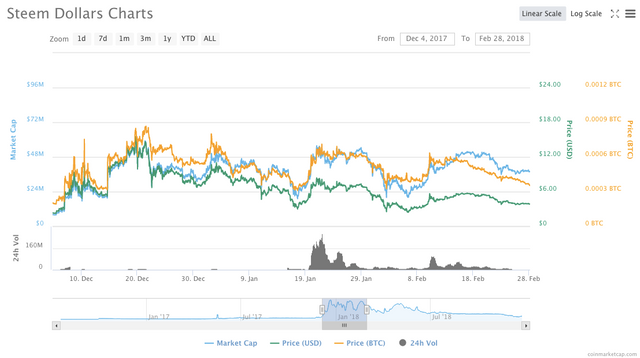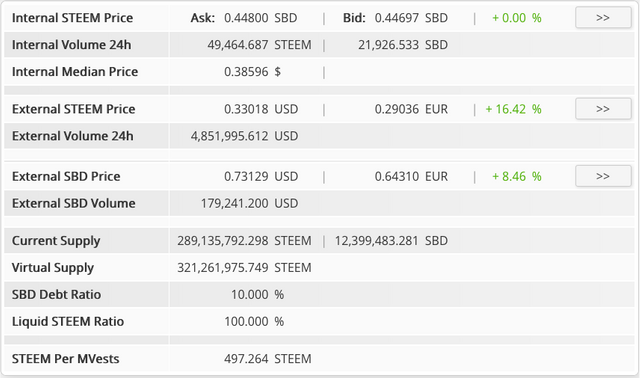A primer to the economics of STEEM blockchain

If you’re here, you should already be familiar with what Steem is and what its goals are. If not, then have a look at this video.
here.
This gives it significant advantage in terms of the number of transactions that it can perform each second, as compared to, let’s say, bitcoin. So let’s begin with a few basics and then move on to the economics driving the blockchain and how it gets the money that eventually gets paid to content creators. However, remember that the goal of this article is to give a primer to the economics and not list all the ways in which the system can be abused and how the STEEM blockchain mitigates those issues.
STEEM
Steem is the liquid currency that can be used for purchasing goods, if your local merchant accepts it. If not, you can always trade it in exchanges to get whichever fiat currency is used in your country and then spend it. Additionally, you can also convert it to long term equity akin to fixed deposits for a certain period of time and earn dividends. You can later choose to cash out that equity for STEEM if you no longer wish to continue. Although STEEM in normal circumstances, additional STEEM is not created by the blockchain, it can sometimes be created as a part of the rewards pool (more on that later).
STEEM Power (SP)
This is the illiquid long term equity that I was talking about, in the previous section. It is deliberately made long term to avoid panic conversions, and offers dividends and voting rights to lure in investors at the risk of slow cashing out. It can be converted back to STEEM over a period of 13 week, with equal payouts given at the end of each week, in case the stakeholder wants to cash out. Having more SP also means that you have more control over how the rewards from rewards pool get distributed amongst content creators. Holders of SP vote to choose a local leader, who is then promoted to the position of a witness. Being a witness is like being a member of the board of directors. There are many of them. One of the jobs of a witness is to produce a price feed (more on that later).
STEEM Dollars (SBD)
This was designed to be similar to 1 USD bonds offered by the STEEM blockchain. Under normal circumstances, you are allowed to convert each SBD to 1 USD worth of STEEM. It is a way of acquiring funding for the STEEM blockchain. Under normal circumstances, the blockchain would print only SBD as a part of rewards pool, which would then get distributed among contributors and is just as liquid as STEEM itself. This means that it can be traded on exchanges or used to purchase goods just like STEEM. One of the advantages of holding SBD is that you get paid with interest, just as if you were holding bonds. The interest rate, however, is decided by the witnesses and can be as low as 0% in case the market price of SBD shoots too high above 1 USD, to de-incentivise the inflation in price. It is important to note that 0% interest rate would mean that the only benefit of holding SBD would be to convert it to STEEM. As you might have already guessed by now, nobody would want to buy each SBD at more than 1 USD and then convert each of those to 1 USD worth of STEEM. This means that every time the SBD price shoots too high above 1 USD, it would essentially be a bubble and users would want to get rid of it in the exchange immediately, until the price at least falls down to 1 USD. As you can see from the graph below, SBD was trading for around 8 USD for quite some time. This was the time when people were panic selling and trying to convert to a currency that was pegged to 1 USD.

So, it’s quite evident the the claims of SBD being pegged to a dollar depends on human intelligence and not by backing every token with a dollar. It is also worth noting that the lower bounds on the pricing of SBD is set by arbitrage traders. If the price is significantly lower that 1 USD, under normal circumstances, traders can buy each SBD token at a price much lower than a dollar and convert each one of them into STEEM worth 1 USD and earn a percentage profit. There is a fair price of SBD that can be determined that actually pegs it to STEEM instead of USD, where you would neither end up profiting nor losing if you convert SBD to STEEM. However, in practically, the time taken for the conversion of SBD to STEEM is intentionally set to a long period of 3.5 days, because the conversion occurs at Internal Median Price (IMP) of STEEM and not the External STEEM Price (ESP) in exchanges. This reduces the chances of immediate conversion of STEEM to SBD and results in a narrow range of values of SBD. This keeps SBD from pegging to STEEM and keeps it close to 1 USD in value.
Price Feed
It is an index of prices created by the witnesses which holds the IMP of STEEM. A set of prices of STEEM are taken, for the purpose of finding a median, over a total period of 3.5 days. This is done to eliminate outliers by corrupt witnesses (Median of large data sets isn’t affected at all, by outliers, as opposed to mean of the data set). The effect of outliers are negligible but the time period is sufficient for other witnesses to vote out the corrupt witness, making the network fully secure once again. Another feature worth noting is that the data points taken for the final calculation of IMP are themselves the median market prices, taken every hour. This is done to reduce the impact of short term huge market fluctuations.
Rewards Pool
This is the pool that holds all the tokens (whether SBD or STEEM) that are eventually distributed amongst contributors. The blockchain generates (or prints) new tokens at a certain rate (that changes with time) and deposits them in the resource pool. It is worth noting that this is a feature that makes the currency inflationary, albeit at a rate that is ever reducing (there is no hard cap on the number of SBD or STEEM to be issued). The rate that new tokens are generated was set to 9.5% per year starting in December 2016, and decreases at a rate of 0.01% every 250,000 blocks, or about 0.5% per year. The inflation will continue decreasing at this rate until it reaches 0.95%, after a period of approximately 20.5 years. 75% of the resource pool is distributed to content creators, 15% is distributed amongst SP holders and 10% is distributed amongst witnesses.
Debt Ratio
Up until now, I have been mentioning the phrase ‘under normal circumstances’. This section will illustrate the abnormal conditions. The debt ratio is defined as:

Where,
n(SBD) = SBD tokens in existance
MC(STEEM) = STEEM market cap
STEEM market cap is calculated as:

Where,
VS = virtual supply
ESP = External STEEM Price
Virtual supply is calculated as:
Virtual supply = current supply if all SBD converted to STEEM.
The ideal debt ratio keeps changing according to what the developers feel is beneficial for the system. As of hard fork 20, the ideal debt ratio is below 9%. From 9% up until 10%, the number of SBD printed decreases linearly and the number of STEEM printed increases linearly. Finally at 10%, only STEEM is printed and SBD printing is halted.
#define STEEM_SBD_STOP_PERCENT_HF14 (5*STEEM_1_PERCENT ) // Stop printing SBD at 5% Market Cap
#define STEEM_SBD_STOP_PERCENT_HF20 (10*STEEM_1_PERCENT ) // Stop printing SBD at 10% Market Cap
#define STEEM_SBD_START_PERCENT_HF14 (2*STEEM_1_PERCENT) // Start reducing printing of SBD at 2% Market Cap
#define STEEM_SBD_START_PERCENT_HF20 (9*STEEM_1_PERCENT) // Start reducing printing of SBD at 9% Market Cap
gpo.sbd_stop_percent = STEEM_SBD_STOP_PERCENT_HF20;
gpo.sbd_start_percent = STEEM_SBD_START_PERCENT_HF20;
dgp.sbd_print_rate = ( ( dgp.sbd_stop_percent - percent_sbd ) * STEEM_100_PERCENT ) / ( dgp.sbd_stop_percent - dgp.sbd_start_percent );
The debt ratio is capped at 10%, because otherwise, bulk conversions of SBD to STEEM and then selling off in the market would impart excessive downward pressure on the market cap of STEEM and the currency would become hyper-inflationary. Even if such bulk conversions don’t offer any incentive, bad actors might want to use it to destabilise the system.
Haircut
Since the debt ratio cannot be allowed to exceed 10% for reasons mentioned in the previous section, a ‘haircut’ is applied to the conversion of SBD to STEEM past that. This means that 1SBD will no longer get converted to 1 USD worth of steem, but a fraction of it, which is given by:
10/Actual debt ratio
Fair Value (FV) of SBD token
Now that we have all the basics needed to understand the economics, let’s calculate a fair value of SBD token. Do note that the actual market value would oscillate around that value, owing to the uncertainty of exchange rates introduced by the delay of 3.5 days for the conversion (as mentioned earlier).
Let’s assume that the interest rate offered to SBD holders is 0%. Let’s assume that we bought ‘x’ tokens of SBD at fair value. The cost incurred (excluding trading fees), is given by:

Now, let’s suppose that the actual debt ratio is at (10+y)%. So the selling price (SP) (total money earned by selling the STEEM received from converting SBD to STEEM) would be given by:

Comparing the selling value to cost, we can say that fair value is given by the equation:

Let’s verify our formula. Here, is a chart of required values at the time of writing:

The actual debt ratio is:

So fair value would be:

We can see that it is nearly the same as the actual price of SBD (which is 0.73129, according to the chart).
Conclusion
Although the operation of the network has been a bit messy, not performance wise, but actually threatening the existence of the platform, due to speculators who didn’t understand the economics, the team has done a good job keeping the process smooth. I think that it’s safe to say that the platform is close to being an engineering marvel.
Congratulations @valkyr! You have completed the following achievement on the Steem blockchain and have been rewarded with new badge(s) :
Click here to view your Board
If you no longer want to receive notifications, reply to this comment with the word
STOPDo not miss the last post from @steemitboard: